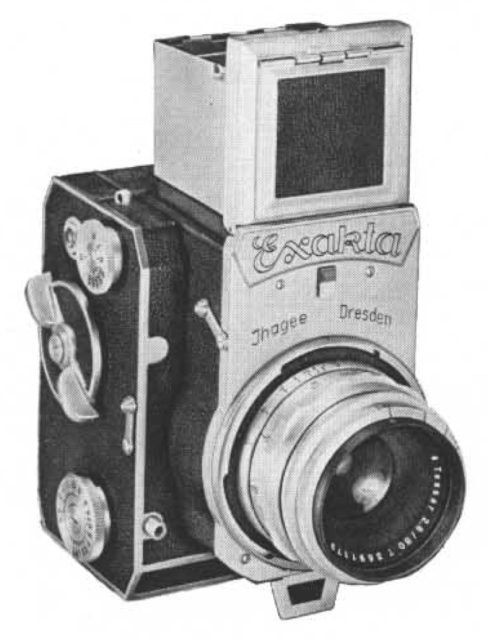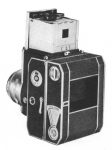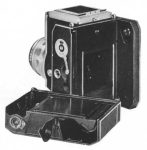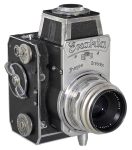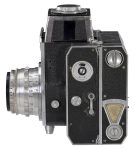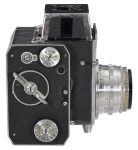Announced
Production type
Availability
System
Exakta 66
Medium format MF film SLR camera • Discontinued • Collectible
Specification
| Format: | |
| Medium format 6x6 | |
Film type: | 120 roll film |
| Exakta 66 (vertical) | |
| Shutter: | |
Type: | Focal-plane |
Model: | Mechanical |
Speeds: | 12 - 1/1000 + B, T |
| Exposure: | |
Exposure metering: | None |
Exposure modes: | Manual |
| Physical characteristics: | |
Weight: | <No data> |
Dimensions: | 139.7x114.3x114.3mm |
Manufacturer description #1
From the EXAKTA Magazine (Vol. 2, No. 2, 1953):
The eagerly-awaited, new 2 1/4 x 2 1/4-inch (6x6-cm.) Exakta probably will available the United States before the end of this year. It is unnecessary to tell Exakta owners what the advantages of such a camera are and how important the new Exakta will be to photographers all over the world. Ihagee has spent many years designing and perfecting this great addition to the single-lens reflex line, and reports from Europe about the camera already have stirred up a beehive of interest. For this reason, we wish to emphasize that the camera is not yet available and that delivery date is indefinite.
The new Exakta will be called the 66. The price has not yet been established, but it will be about $300 with the standard lens. This will be the redesigned 80-mm., Zeiss Jena Tessar with built-in preset diaphragm mechanism and sunshade.
The 66 takes 12 pictures, 2 1/4 x 2 1/4 inches in size, on 120 rollfilm. The shape and design are radically different from the experimental model of this camera, which was introduced in 1939.
The body is now roughly square in shape, measuring 5 1/2 inches high, 4 1/2 inches wide and 4 1/2 inches deep (without lens). All important operating mechanisms are located on the right side.
The two-curtain cloth shutter and two speed setting knobs are similar to those of the 35-mm. Exakta models. The two knobs also are similar to those of the miniature Exakta and provide 29 speed settings ranging from 1/1000 of a second to 12 seconds for instantaneous release. Delayed action exposures can be made up to a speed of 6 seconds.
The new Exakta has an automatic film-transport, shutter-cocking mechanism that operates from the first frame. An ingenious indicator on the camera back indicates that the first frame has been reached. The film-transport mechanism locks until the exposure has been made. Then the film can be advanced only enough to bring the next frame into position back of the lens. The combination ratchet-type film-transport winder is given a half-turn to advance the film and frame counter and to cock the shutter. Double exposures are possible.
The shutter release is on the right side of the camera on the front of the body next to the lens. It has a safety lock on it.
The interchangeable 80-mm. Tessar, in addition to the preset diaphragm mechanism, has distance scales in both feet and meters. Additional lenses will be available ranging in focal length from 56 to 400 mm. Several wide-angles, f/3.5 Primotars of 85, 165 and 180 mm. and f/5.5 Meyer Tele-Megors of 150, 180, 250 and 400 mm. will be available.
The back of the camera is removable and can be locked with a swinging lever. Interchangeable backs will be available in the future. An indentation in the back affords a fingerhold for grasping and steadying the camera. A folding metal strip below the lens can be used for steadying the camera or balancing it when it is placed on a flat surface.
Built-in flash synchronization is provided by means of a single socket on the left, top side of the camera. The same socket is used for both regular and electronic flash and an adjustable scale permits the time delay to be altered within the 0-20 millisecond range.
The folding viewfinder is removable for interchange with other viewfinders which will be available. The camera will come with the standard viewfinder which can be used at waist level or, if the front window is opened, as an eye-level, sports finder. An eye-level Penta Prism will be available as an accessory.
The standard viewfinder includes a hinged magnifier equipped with an eyepiece for focusing comfort. The magnifier covers the entire ground glass area. The ground glass is a condenser type element with a finely ground base for brighter illumination.
Other features include a film notes device, loops for neckstraps, tripod sockets on both the bottom and side of the camera and an eveready case.
Manufacturer description #2
From the "Equipment information from Exakta" booklet (1954):
We are proud to introduce the eagerly-awaited, new 2 1/4 X 2 1/4-inch (6 X 6-cm) Exakta 66. It is unnecessary to tell Exakta owners what the advantages of such a camera are and how important the new Exakta will be to photographers all over the world. Ihagee has spent many years designing and perfecting this great addition to the single-lens reflex line, and reports from Europe about the camera already have stirred up a bee-hive of interest and enthusiasm. The price is $319.50 with the redesigned 80-mm., f/2.8 Zeiss Jena Tessar lens with built-in preset diaphragm mechanism.
The "66" takes 12 pictures, 2 1/4 X 2 1/4 inches in size, on 120 rollfilm. The shape and design are radically different from the experimental model of this camera, which was available prior to World War II.
The body is now roughly square in shape, measuring 5 1/2 inches high, 4 1/2 inches wide and 4 1/2 inches deep (without lens). All important operating mechanisms are located on the right side.
The two-curtain cloth shutter and two speed setting knobs are similar to those of the 35-mm. Exakta models. The two knobs also are similar to those of the miniature Exakta and provide 29 speed settings ranging from 1/1000 of a second to 12 seconds for instantaneous release. Delayed action exposures can be made up to a speed of 6 seconds.
The new Exakta has an automatic film-transport, shutter-cocking mechanism that operates from the first frame. An ingenious indicator on the camera back indicates that the first frame has been reached. The film-transport mechanism locks until the exposure has been made. Then the film can be advanced only enough to bring the next frame into position. The combination ratchet-type film-transport winder is given a half-turn to advance the film and frame counter and to cock the shutter. Intentional double exposures are possible.
The shutter release is on the right side of the camera on the front of the body next to the lens. It has a safety lock on it.
The interchangeable 80-mm. Tessar, in addition to the preset diaphragm mechanism, has distance scales in both feet and meters. Additional lenses will be available ranging in focal length from 56 to 400 mm. Several wide-angles, f/3.5 Primotars of 85, 165 and 180 mm. and f/5.5 Meyer Tele-Megors of 150, 180, 250 and 400 mm. will be available.
The back of the camera is removable and can be locked with a swinging lever. Interchangeable backs will be available in the future. An indentation in the back affords a fingerhold for grasping and steadying the camera. A folding metal strip below the lens can be used for steadying the camera or balancing it when it is placed on a flat surface.
Built-in flash synchronization is provided by means of a single socket on the left, top side of the camera. The same socket is used for both regular and electronic flash and an adjustable scale permits the time delay to be altered within the 0-20 millisecond range.
The folding viewfinder is removable for interchange with other viewfinders which will be available. The camera will come with the standard viewfinder which can be used at waist level or, if the front window is opened, as an eye-level, sports finder. An eye-level Penta Prism will be available as an accessory.
The standard viewfinder includes a hinged magnifier equipped with an eyepiece for focusing comfort. The magnifier covers the entire ground glass area. The ground glass is a condenser type element with a finely ground base for brighter illumination.
Other features include a film notes device, loops for neckstraps, tripod sockets on both the bottom and side of the camera and an eveready case.
Manufacturer description #3
The Exakta 66 has achieved a high measure of recognition among professional and amateur photographers. This wide acceptance is indicated by the fact that the "66" is in constant use throughout the world on professional, editorial, advertising, fashion, and similar assignments. Be it fashion salons in Paris, bazaars in Bombay, or on New York's Fifth Avenue, you can be sure the "66" is clicking away with consistently brilliant results.
The Exakta 66 is a single-lens reflex camera in which all focusing and viewing take place in the waist-level viewfinder. You see a sparkling, upright and enlarged image on the ground glass. There is no guesswork, no parallax, no complicated procedures. This folding viewfinder is also equipped with a built-in magnifier for critical focusing, or if its front window is opened, can be used as an eye-level, sports finder. The viewfinder assembly is designed to accept a split-image rangefinder; by pressing a button, the unit can be removed for cleaning and inspection.
The "66" is equipped with the famous f/2.8 Carl Zeiss Tessar 80-mm. lens with preset diaphragm mechanism, which focuses from 3 feet to infinity, and stops down to f/22. It incorporates the unique Exakta feature of an extremely wide range of shutter speed settings, from 1/1000 of a second to 12 seconds. The shutter settings are 1/1000, 1/500, 1/250, 1/150, 1/100, 1/50, 1/25, 1/5 and 1/2 of a second and 1, 2, 3, 4, 5, 6, 7, 8, 9, 11 and 12 seconds plus bulb and time. A built-in self-timer is also provided so that the photographer can include himself in the picture. The self-timer works with fast and slow speeds.
Utilizing the popular 120 rollfilm, the "66" takes 12 pictures, 2 1/4 x 2 1/4 inches in size (6 x 6 cm.), in color and black and white. Winding the film automatically cocks the shutter making it possible to take picture after picture with great rapidity. Built into the back of the camera body is a clever indicator that reveals when the first frame is in a picture-taking position. The film transport mechanism locks until the exposure has been made. After the exposure, the film can only be advanced to the next frame. The half turn needed to move the film also cocks the shutter and operates the exposure counter. The shutter release is positioned on the right side of the camera and has a safety lock to prevent unintentional double exposures. However, double exposures can be made when desired.
The "66" has been designed so that lenses can be interchanged in a matter of seconds. A variety of telephoto lenses are available now... more telephoto and wide angle lenses ranging from 56 to 400-mm. will be available. Since you always view through the picture-taking lens, no special viewfinders or attachments are needed with any lens on the "66", be it a telephoto, wide angle, standard or high speed.
Close-up photography with the " 66" is simple. By attaching a bellows extension or a set of extension tubes, you can do wonderful close-up photography. Additional viewfinders are not necessary as the object to be photographed is viewed continuously in the incomparable Exakta viewfinder right up to the moment of exposure.
The Exakta 66 is fully synchronized for regular and electronic flash. A single socket on the left, top side of the camera is used for both types of flash. An adjustable scale permits the time delay to be altered with the 0-20 millisecond range.
The back of the camera is removable and can be locked with a swinging lever. An indentation in the back affords a fingerhold for grasping and steadying the camera.
Compactly designed for easy handling, the "66" is almost square in shape, measuring 5 1/2 inches high, 4 1/2 inches deep and 4 1/2 inches wide (without lens). All important operating mechanisms are located on the right side of the body.
Other features include a film-notes device, loops for neckstraps and tripod sockets on both the bottom and side.
Manufacturer description #4
Photographers prefer the Exakta 66 because of its versatility, large film size, and ability to render perfect results no matter what the assignment. The single lens reflex principle insures complete elimination of parallax at all times, and provides a brilliant ground-glass image. Control over depth-of-field is always in the hands of the photographer who can choose his area of sharp focus by visual observation and with absolute precision. The ground-glass image, large and life-like, eliminates completely squinting and eye-strain, makes picture-taking comfortable and allows the photographer to concentrate on his subject.
The large negative size, 2 1/4 x 2 1/4 inches (6 x 6 cm), provides the advantage of grain-free enlargements up to 16 x 20 inches and beyond. This, combined with a sharp-cutting lens, insures superlative definition which will easily surpass the most critical standards.
Standard lens equipment is the matchless f/2.8 Carl Zeiss Jena Tessar 80-mm lens with pre-set diaphragm, focusing range from 3 feet to infinity, and stops down to f/22. Viewing is through the lens at all times. You see precisely what you get with focusing at maximum aperture, shooting at any pre-determined aperture with a simple twist of the wrist. The built-in magnifier further insures absolute critical focusing. In addition, the snap-up folding viewfinder is combined with an eye-level sportsfinder for complete follow-focus versatility when your subject is in motion.
The "66" offers the unique Exakta range of shutter speeds, including 1/1000, 1/500, 1/250, 1/150, 1/100, 1/50, 1/25, 1/5, and 1/2 second, plus 1, 2, 3, 4, 5, 6, 7, 8, 9, 11 and 12 seconds along with Bulb and Time settings. A self-timer, which operates at both fast and slow speeds, is also built-in.
Popular, 120 rollfilm, available anywhere, is used either color or black-and-white, to provide twelve 2 1/4 inch square pictures. Film wind is linked with shutter cocking, for swift and efficient picture-taking, as well as double exposure prevention, although provision is made for intentional double exposures. In the back of the body you will find a built-in indicator to tell you when the first frame is in taking position. The film transport mechanism locks automatically after winding and until exposure. After exposure, you wind the film to the next frame and feel it come to an automatic stop. A coupling mechanism counts exposures as you transport each frame. The shutter release is conveniently positioned on the right side of the camera body, and features a special safety lock to prevent accidental tripping.
Telephoto lenses all interchangeable in split-seconds with the fool-proof Exakta bayonet mount, are now offered. Focal lengths range from 135mm to 400mm. No extra viewfinders are ever needed, since each lens provides through the lens viewing with all its attendant advantages.
Close-up work with the Exakta "66" is equally simple. Attach the bellows extension to the bayonet mount, or use a set of extension tubes. You'll see the image of the subject right on the ground-glass up until the exact moment of shutter release. As with the lenses, no special viewfinders are necessary. What you see is what you get.
The "66" is fully synchronized for both regular and electronic flash. A single, foolproof outlet at the left, top side of the camera is used for all flash connections. Synchronization delay time is completely adjustable from 0 to a full delay of 20 milliseconds.
Designed to fit into your hand and especially balanced for handling, the Exakta "66" is 5 1/2 inches high, 4 1/2 inches deep and 4 1/2 inches wide (without its lens). All operating mechanisms are conveniently located on the right side of the camera body.
Additional features: a film-notes device, loops for neck-strap and tripod sockets on both bottom and side.
From the editor
The camera was presented by Ihagee East at 1953 Leipzig Autumn Fair and produced for only a few years (most likely 1953-1954).
